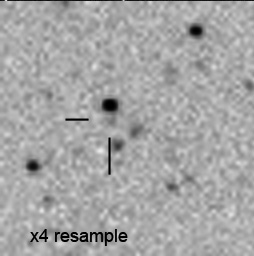Forum Replies Created
-
AuthorPosts
-
14 April 2021 at 7:59 am in reply to: Introducing MetroPSF – a program for ensemble photometry #584093
 Nick JamesParticipant
Nick JamesParticipantMaxim – Thanks, I’m almost there. I had forgotten the “Get comparison stars” step! Now I get a fit. The only problem remaining is when I click on the object the flux/magnitude etc are all zero. What am I doing wrong?
One other question – Am I right that the ensemble fit graph is upside down, i.e. the brightest magnitudes are in the lower left corner. Not a problem but I would just like to understand.
12 April 2021 at 7:22 am in reply to: Introducing MetroPSF – a program for ensemble photometry #584088 Nick JamesParticipant
Nick JamesParticipantThanks. I get an error “630 match_mag” when computing the regression model. now.
10 April 2021 at 8:25 pm in reply to: Introducing MetroPSF – a program for ensemble photometry #584082 Nick JamesParticipant
Nick JamesParticipantMichael – Yes, it seems to work fine without the astrometry.net key although my files are already platesolved. Here’s an example of the V1391 Cas field with the fit using V.
Maxim – Could you add Gaia DR2 G to your list of catalogues? Also, the image contrast stretch doesn’t seem to work very well for me.
10 April 2021 at 6:56 am in reply to: Introducing MetroPSF – a program for ensemble photometry #584077 Nick JamesParticipant
Nick JamesParticipantMaxim – Thanks that works fine, see attachment. I’ll have a look through your documentation later and will do some experiments on known fields.
9 April 2021 at 10:09 pm in reply to: Introducing MetroPSF – a program for ensemble photometry #584073 Nick JamesParticipant
Nick JamesParticipantI’ve just converted the FITS that I was using from int16 to float32 and it now works. I have an image. I’ll play around a bit more.
9 April 2021 at 10:06 pm in reply to: Introducing MetroPSF – a program for ensemble photometry #584072 Nick JamesParticipant
Nick JamesParticipantYes, I get the same on Win 10. FITS data but no image. See the attached screenshot. FITS file is attached. Note that it is a gzip compressed fits but I can only attach files with an extension .fits so you may need to change that to fit.gz to get it to work.
9 April 2021 at 9:57 pm in reply to: Introducing MetroPSF – a program for ensemble photometry #584071 Nick JamesParticipant
Nick JamesParticipantI get the same problem trying to install 3.9.4 direct from the Python website into a fresh Win 10 20H2 instance in a VM. Trying to run pip from Powershell gives a “command not recognised” error. Installing from the MS Store worked. The rest of the install then ran smoothly although it did moan about ‘wheel’ not being installed as per the attached screenshot and has various warnings (see screenshot). I’m assuming these are benign. I’ll try out the program now.
 Nick JamesParticipant
Nick JamesParticipantYes, I get 13.8 unfiltered ref Gaia DR2 G tonight. Image here.
 Nick JamesParticipant
Nick JamesParticipantCBET 4945 designates this nova as V1405 Cas. My image of it and M52 which is a degree to the north is here.
 Nick JamesParticipant
Nick JamesParticipantYes, and I can see it just below M52. I’m not sure about making a magnitude estimate though!
 Nick JamesParticipant
Nick JamesParticipantThe astrometry I get using Gaia DR2 is 23:24:47.70 +61:11:14.8 with a very high SNR and 1.29 arcsec/pix sampling. There are four stars within 5″ in Gaia DR3. The closest to that position is 15.36G offset by 0″.47 in RA, 0″.04 in Dec.
 Nick JamesParticipant
Nick JamesParticipantAttached stack of 11x1s shows it around 7.6 unfiltered (Gaia G reference) just now (Mar 19.80).
 Nick JamesParticipant
Nick JamesParticipantJust edited the link so that it works.
 Nick JamesParticipant
Nick JamesParticipantAnd 14.89 just now (March 11.84) in a howling gale.
 Nick JamesParticipant
Nick JamesParticipantMy latest observation was on March 9.8 when it was 15.39 (ref Gaia G). My data is in the VSS database.
 Nick JamesParticipant
Nick JamesParticipantThe nova has been steadily brightening for a few weeks and tonight I get it at 17.42. At this rate it will be brighter than the close star just to the north in a few days. An interesting object to follow just as Cassiopeia is getting low in the north. How bright will it get?
 Nick JamesParticipant
Nick JamesParticipantYes, the first comet photos, by Underwood and Bond, were of C/1858 L1 (Donati) in 1858. With the help of Mike Maunder we estimated that these would have been taken using Collodion plates that had a sensitivity of around 0.05 to 0.1 ISO . By the time of Lockyer’s attempts in 1874 he would have been using gelatine plates with a sensitivity of maybe 0.2 ISO. No wonder it was so hard to photograph a comet but even then people knew to use short, fast lenses. Did Lockyer try any photography using a portrait lens? Eight years later, in 1882, Gill got his famous photo of C/1882 R1 which led to the Cart du Ciel project.
 Nick JamesParticipant
Nick JamesParticipantI don’t have mine yet either but the post in Chelmsford is badly affected by Covid and, possibly the inch of snow that fell on Monday.
 Nick JamesParticipant
Nick JamesParticipantThe AAVSO lightcurve shows recent observations between 18-19 which I am sure are wrong. I’ve been keeping this star under regular observation and I have not seen it this bright since early January. The nova is only a few arcsec south of a 17th mag star and I think that is affecting measurements. In the thumbnail below, taken from my image of last night, the nova is visible faintly between that star and a fainter one further to the south. The fainter star is 18.5 and the third star at the right angle of the triangle is fainter than 19. The nova is much fainter than that. I get 20.1 in a 4 arcsec radius aperture which is offset 2 arcsec south to avoid including the 17th mag star.

 Nick JamesParticipant
Nick JamesParticipantThe nova is just visible on an image taken tonight at around mag 20. I’ve not seen it on stacks with a similar limiting magnitude to tonight’s image so it may be on the rise again.
-
AuthorPosts
